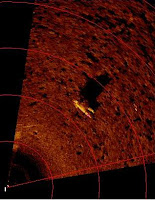 |
| A body located in Long Beach with sonar |
The LAFD maintains and operates two types of marine sonar that assists in search, rescue and recovery. Boat 2 operates an Edgetech Towfish Side Scan Sonar while Boat 4 operates a Kongsberg Mesotech Mechanically Scanned Sonar. Both provide a broad range of versatility in the mapping and locating of submerged objects or victims.
About Sonar
Sonar, also written SONAR, is formally an acronym for Sound Navigation and Ranging. It connotes an acoustic system that can be used as an aid to navigation and that can determine the range, or distance, to objects, also called targets. The range r to a single target is determined by measuring the time of flight t of an acoustic signal, or ping, from its transmission to the reception of the echo, Originally, development of sonar was spurred by the sinking of the “Titanic” through collision with an iceberg. The intention of the development was to devise an underwater collision-avoidance method. As the term is currently used, sonar refers to a system that can determine the range and direction to objects in the water column as well as boundary surfaces such as the sea floor. The essential elements of sonar are (1) a transducer, (2) electronics to control the excitation of the transducer and reception of echoes, including their amplification and other processing, and (3) a display. Implicit in this definition is control or knowledge of the orientation of the transducer.
LAFD Towfish Side Scan Sonar
 |
| FF Matt Fistonich prepares the towfish for deployment |
A side scan sonar system uses acoustic energy to image the seafloor. The system consists of a self-contained sound source and receiver, housed in a submersible body that is towed from a surface vessel. The subsurface unit, or "towfish", transmits and receives acoustic energy in a wide band across the track of the towfish, and transmits the signal to a topside processor. The towfish is equipped with a linear array of transducers that emit and receive an acoustic energy pulse in a specific frequency range. The strength of the acoustic return varies with changes in the characteristics of the seafloor. In general, a seafloor with rough texture, such as gravel or boulders, will produce more backscatter in the return signal, resulting in higher amplitude. This pattern results in lighter shades of gray on the resulting side scan image.
 Smoother texture, such as a sand or mud-dominated seafloor, returns a darker image. As the towfish transverses the survey area, a strip image is produced by the processor. These strip images are then georeferenced and spatially integrated into a mosaic that represents the acoustic character of the seafloor.
Smoother texture, such as a sand or mud-dominated seafloor, returns a darker image. As the towfish transverses the survey area, a strip image is produced by the processor. These strip images are then georeferenced and spatially integrated into a mosaic that represents the acoustic character of the seafloor. LAFD Mesotech Sonar
 |
| A marker references the location |
It's design is targeted at bottom clearance and is ideal for body recovery and applications where data clarity supersedes any other requirement. This sonar is used from a fixed position and provides the ability locate and clearly define targets as well as measure distances and size. One of the greatest advantages is the ability to monitor, track and direct divers for rescue or recovery. It is particularly helpful in black water conditions with the ability to direct the rescue divers to the target. Real-time data from the scanning sonar gives surface support personnel the perspective of what's happening on the bottom. The sonar can "see" beyond the eyes of the diver and monitor the surrounding conditions.
For more information on sonar support see the link provided:
 |
| Diver's bubble pattern can be seen approaching the victim |
No comments:
Post a Comment